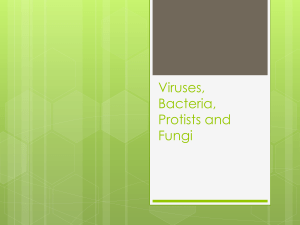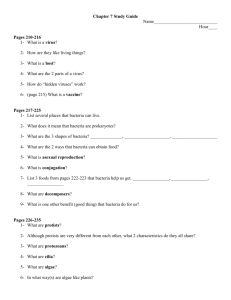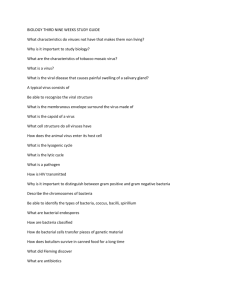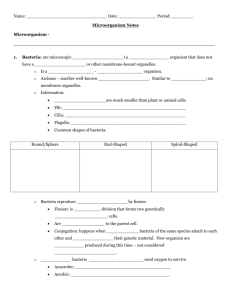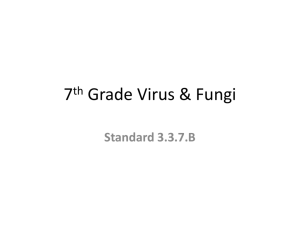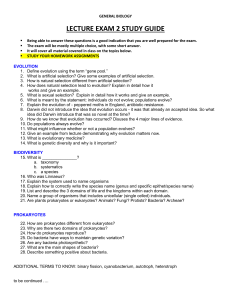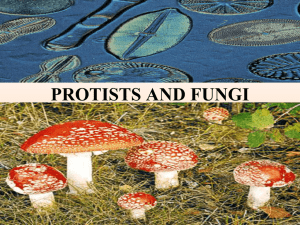Science 8 Review
advertisement
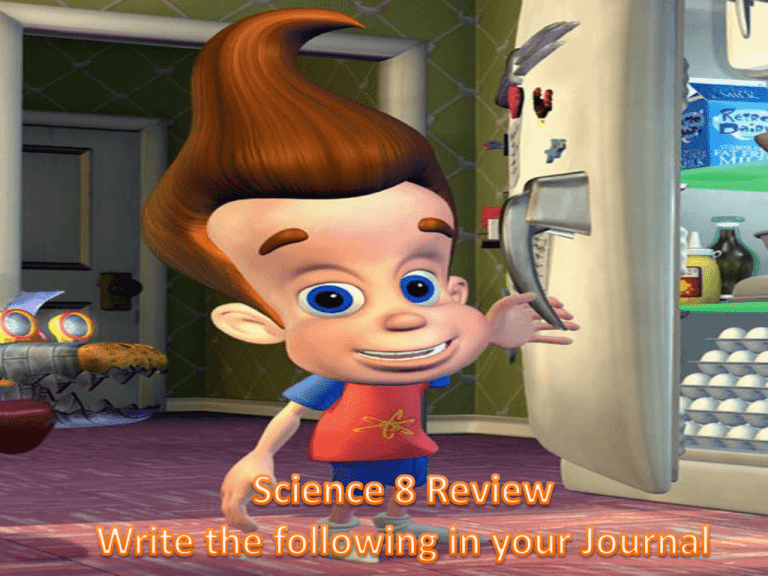
KEY IDEAS: VIRUSES 1. viruses are considered to be nonliving because viruses are not cells, and they do not use energy to grow and develop, or to respond to their surroundings. 2. all viruses have two basic parts: an outer coat that protects the virus and an inner core made of genetic material. 3. once inside a cell, a virus uses the host cells’ functions to make its own proteins and genetic material. The proteins and genetic material assemble into new viruses. Which burst destroying the host. KEY IDEAS: BACTERIA 1. Bacteria are prokaryotes. Their cells do not have nuclei that contain the cell’s genetic material. Instead, the genetic material floats freely in the cytoplasm. 2. Bacteria reproduce asexually by binary fission, which results in the production of two cells exactly like the parent cell. Some bacteria have a simple form of sexual reproduction called conjugation. This process results in a cell with a new combination of genetic information. 3. Bacteria play positive roles in the lives of humans. Bacteria are involved in fuel and food production, in environmental recycling and cleanup, and in the production of medicines. VIRUSES, BACTERIA AND YOUR HEALTH 1. Infectious disease can spread through contact with an infected person, a contaminated object, an infected animal, or an environmental source. 2. There is no cure for viral disease. Bacterial disease can be cured through the use of antibiotics. Vaccines can prevent some viral and bacterial diseases. KEY IDEAS: PROTISTS 1. Animal-like protists, or protozoans, include sarcodines, ciliates, zooflagellates, and sporozoans. Like animals, these protists are heterotrophs. Most protozoans move by using pseudopods, cilia, or flagella. 2. Fungus like protists include water molds, downy mildews, and slime molds. Like fungi, these protists are heterotrophs, have cell walls, and use spores to reproduce. 3. Plantlike protists, or algae, include euglenoids, dinoflagellates, diatoms, green algae, red algae, and brown algae. Like plants, these organisms are autotrophs. KEY IDEAS: ALGAL BLOOMS 1. Red tides occur when a population of algae increases quickly in ocean waters. Some algae can secrete toxins that poison animals. 2. Nutrients in a lake or pond build up over time, causing an increase in the numbers of algae. An accelerated rate of eutrophication can lead to the deaths of many organisms in the lake or pond. KEY IDEAS: FUNGI 1. Most fungi are eukaryotes, use spores to reproduce, and are heterotrophs. 2. Most fungi feed by absorbing food through their hyphae. The hyphae secrete digestive chemicals into a food source, which is broken down into small substances that are absorbed by the hyphae. 3. Fungi produce spores in structures called fruiting bodies. The majority of fungi reproduce both asexually and sexually. 4. Fungi are decomposers that recycle Earth’s chemicals. In addition, some fungi cause disease while some fight disease. Many produce important foods for people. Some fungi live in symbiotic relationships with other organisms. KEY IDEAS: THE PLANT KINGDOM 1. Plants are autotrophs. All plants are also multicellular eukaryotes. 2. Plants cells have cell walls that are made mostly of cellulose. Plants cells contain chloroplasts, in which food is made, and vacuoles that store water, food, and other substances. 3. All plants have complex life cycles. In the sporophyte stage, plants produce spores. In the gametophyte stage, plants produce sperm cells and egg cells. 4. For plants to survive on land, they need ways to obtain water and other materials from their surroundings, retain moisture, support their bodies, transport materials throughout the pant, and reproduce successfully. KEY IDEAS: PHOTOSYNTHESIS AND LIGHT 1. White light is made up of the different colors of the rainbow-red, orange, yellow, green, blue, and violet. 2. Most of the light that strikes a leaf is absorbed by pigments in the chloroplasts of the cells. Chlorophyll, the main pigment, absorbs red and blue light. Light energy powers the process of photosynthesis. 3. In photosynthesis, carbon dioxide and water are converted into sugars and oxygen using the light energy. KEY IDEAS: MOSSES, LIVERWORTS, AND HORNWORTS 1. Nonvascular plants are small, low-growing plants that lack vascular tissue. Most nonvascular plants transport materials by passing them from one cell to the next. They live in areas where they are enough moisture for them to survive. 2. Mosses, liverworts, and hornworts are three types of nonvascular plants. KEY IDEAS: FERNS AND THEIR RELATIVES 1. Seedless vascular plants have vascular tissue and sue spores to reproduce. These plants include ferns, club mosses, and horsetails. 2. Although seedless vascular plants grow taller than nonvascular plants, they still need to live in moist places. The plants’s spores are released into the environment, where they grow into gametophyte.

